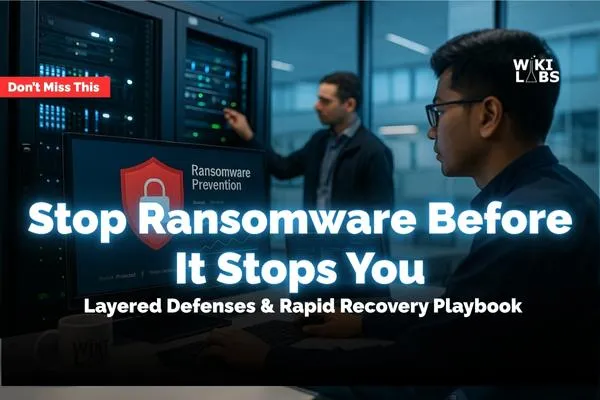
Stopping Ransomware in Its Tracks
Ransomware Prevention & Response
Introduction
Ransomware attacks grew by over 50% last year, targeting organisations of all sizes. A single successful breach can encrypt critical data, disrupt operations and demand six-figure ransoms. Prevention is your first line of defence—but preparation for a rapid response is equally vital.

Understanding Ransomware Today
Malware delivery: Often via phishing emails, malicious links or compromised software updates.
Double extortion: Attackers exfiltrate data before encrypting it, threatening to leak sensitive files even if you pay.
Ransom demands: Average ransom payments now exceed RM 1 million per incident.
“Ransomware isn’t just about encryption—it’s a business model for cybercriminals.”
Worried your organisation could be next? Get a free ransomware risk assessment now.

Prevention Strategies
Secure, Immutable Backups
Maintain offline or cloud-based write-once, read-many (WORM) backups.
Automate regular backup verification and test restores.
Patch Management & Application Control
Apply critical OS and software patches within 72 hours.
Use application whitelisting to block unauthorised executables.
Email Defences & User Training
Deploy advanced email filtering and sandboxing.
Conduct quarterly phishing simulations and awareness workshops.
Network Segmentation
Isolate critical systems behind firewalls and VLANs.
Limit lateral movement with zero-trust micro-segmentation.
Least-Privilege Access
Enforce role-based access controls (RBAC).
Disable admin privileges on endpoints by default.

Incident Response & Recovery
Detection & Containment
Monitor endpoints and networks for anomalous file activity.
Immediately isolate infected devices from the network.
Eradication & Forensics
Identify and remove all traces of the ransomware payload.
Collect logs and memory images to understand the attack vector.
Data Restoration
Restore from the most recent clean backup.
Validate integrity before reconnecting systems to production.
Communication & Reporting
Activate your incident-response team and notify stakeholders.
Report breaches as required under PDPA and other regulations.
Post-Incident Review
Analyse root causes and update playbooks.
Retrain staff and refine technical controls based on lessons learned.

Real-World Success Story
A Malaysian financial services firm detected a ransomware payload during a routine scan. By:
Isolating the infected segment in under 5 minutes,
Switching to offline backups stored in a WORM-protected vault, and
Following a pre-tested recovery playbook, they restored all services within 4 hours—averting an estimated RM 2 million in lost transactions and repetitional damage.
Inspired by this turnaround? Book a workshop to build your tailored recovery playbook.

How to Begin
Audit Your Backups: Ensure they’re immutable and tested regularly.
Harden Endpoints: Apply patches, enable application control and deploy EDR.
Segment Your Network: Use VLANs, firewalls and zero-trust micro-segmentation.
Develop & Test Playbooks: Run tabletop exercises quarterly.
Train Your People: Launch phishing drills and security awareness campaigns.

Conclusion
Ransomware can strike at any time—prevention and swift recovery are non-negotiable. By layering defences and having a solid response plan, you can neutralise threats and restore operations quickly.
Ready to defend against ransomware and secure your recovery?
Contact us for a ransomware-resilience assessment and response workshop.
References
Sophos, “State of Ransomware 2024,” April 2024
IDC, “Market Analysis: Backup & Recovery Solutions,” Q1 2024
NIST SP 800-61r2, “Computer Security Incident Handling Guide,” 2012
Cybersecurity & Infrastructure Security Agency (CISA), “Ransomware Guide,” 2023
Wiki Labs internal incident-response benchmarks, 2025
